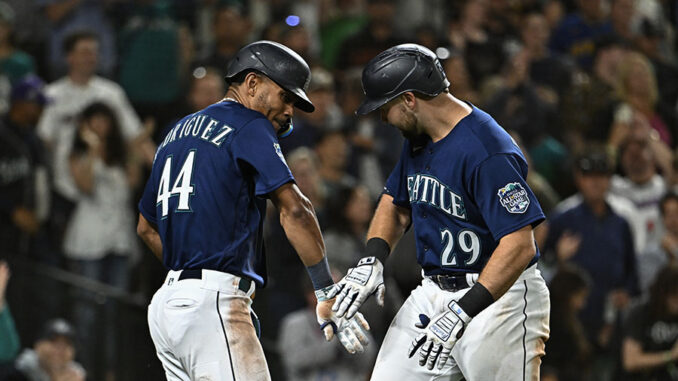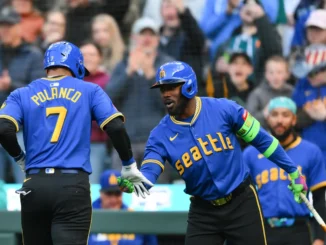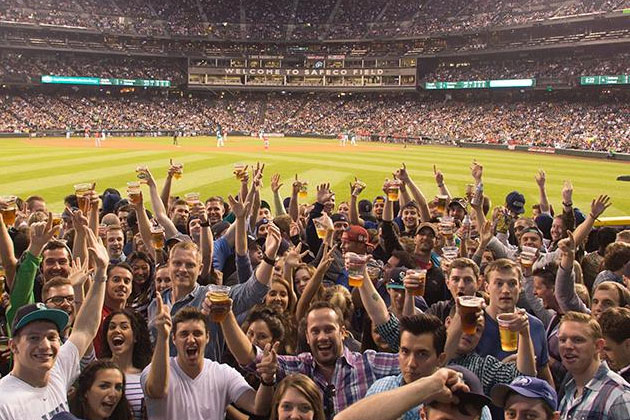
With the World Series now in the rear-view mirror, the Seattle Mariners find themselves in an unenviable position.
Last year at this time, they were riding high, coming off their first playoff appearance in 21 years and looking to find a way not just to make the playoffs again but to win the division and maybe win the World Series for the first time.
Instead, the Mariners spent much of the season treading water around .500, and then a faceplant in the final two weeks of the season kept them home for the playoffs. They could only watch as division rivals Texas and Houston battled it out in the American League Championship, and the Texas Rangers won that franchise’s first World Series championship.
Having been caught, passed, and lapped by Texas in the pantheon of American League teams, the Mariners have their work cut out for them this offseason if they want to finish in the top half of the division standing, much less make the playoffs.
The Mariners head into the offseason with plenty of holes to fill. In order of priority, the team could use upgrades at designated hitter, first base, left field, second base, and right field if they will hang with the Rangers or Astros next year: no big deal, just five of the nine spots in the lineup.
Unfortunately, improving any of those spots doesn’t seem to be an easy task. Over the past two years, teams were blessed with a bountiful crop of free agent hitters to pick from. The Rangers readily took advantage, handing out massive contracts to second baseman Marcus Semien and shortstop Corey Seager to bolster a young crop of hitters they were developing. The Mariners largely sat on the sidelines of the free agent fiesta, bringing in bargain-basement offensive additions along with starting pitcher Robbie Ray.
While Semien and Seager were in the drivers’ seats of the high-powered Rangers offense this year, Ray provided a middling effort in 2022 and then missed the entire 2023 season and will miss most of 2024 after needing Tommy John surgery. After missing on all the free agent hitters over the last two years, the Mariners find themselves with a much smaller lot to pick from this year.
Their white whale (and the same target as pretty much every team in the league) will be Shohei Ohtani. The Japanese two-way standout hits free agency after redefining what it means to be a star player with the Angels. While an injury will keep him off the pitcher’s mound in 2024, every team would love to add his bat to the lineup. Even with missing the final month of the season, Ohtani turned in arguably his best offensive season to date, hitting .304 with a .412 on-base percentage and 44 home runs last year. As much as every team would love to have him, it’s unclear what Ohtani wants in his next team. Will he sacrifice money to play for a winner? Does he already have a preferred destination that he’ll go to if they put in a competitive offer? Does he want to stay on the west coast? Or is he just looking for the biggest deal possible, regardless of location? No one knows. The Mariners should absolutely be willing to hand Ohtani whatever he wants, but if he doesn’t want to play for a team that doesn’t seem committed to doing what it takes to win, it’s possible no amount of money would lure him to Seattle. On the other hand, the Mariners should absolutely not make a face-saving bid for Ohtani, swing, and miss, and then say, “Oh well, we tried,” and call it an offseason. If the Mariners do land Ohtani, it should be as a massive, delicious cherry on top of other offseason additions, not the culmination of the singular effort of the offseason.
The biggest problem is, outside of Ohtani, there isn’t a lot of “there” there in the free agent pool, meaning that in order to acquire talent, the Mariners will probably need to subtract talent by trading from their stable of young pitchers, a situation the team might have been able to avoid by spending money in the right places over the last few years.
That being said, there are a few free agents the Mariners could look to add to bulk up their roster. The first is first baseman/outfielder Cody Bellinger, who, after several disappointing years with the Dodgers, posted a rebound season with the Chicago Cubs last year. It’s difficult to know if his future is the player who struggled to stay above the Mendoza line with the Dodgers or the one who posted a .356 on-base percentage with 26 home runs with the Cubs. He could fill two positions of need for the Mariners. J.D Martinez would be a possible fit as designated hitter and has been consistently productive over his career. However, he is 36 and would only be a stopgap solution. Slightly younger at 32 is Jorge Soler, who could replace Teoscar Hernandez as a designated hitter or in a corner outfield spot. The final choice among the top tier is Jung Hoo Lee, a 25-year-old centerfielder from the Korean Baseball League. He has hit well over seven seasons in Korea, as well as at last year’s World Baseball Classic. However, he has plenty of questions about how well his game will transition to the significant league level.
If the Mariners do go the trade route, there are many different paths they could take. Still, their primary targets should be San Diego outfielder Juan Soto and Minnesota second baseman Jorge Polanco. Both are players in the final year of their contracts on teams looking to shed salary. Soto is one of the premier talents in baseball. If the Mariners could keep him long-term (a tough task considering he is a client of Scott Boras, who rarely agrees to extensions without testing free agency), he would be an ideal long-term outfield partner with Julio Rodriguez. Polanco would be the Mariners’ next attempt to find a decent option at second base and would hopefully give them a year of competent second base play while they continue to try and develop internal options.
No matter what path they choose this offseason, the Mariners have a long way to go and a high mountain to climb to prove they are ready to return to the playoffs.




